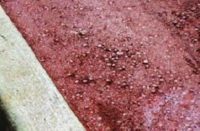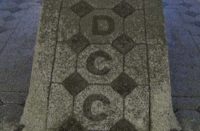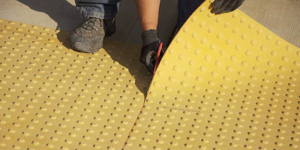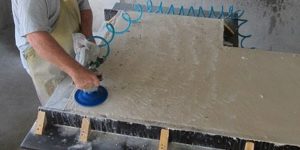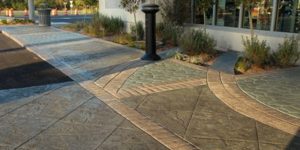
A seaside town is defined by its boardwalk. And for too long, the boardwalk in Bandon, Ore., was an unimpressive asphalt path.
Bandon attracts its share of tourists, who stop to play golf, take chartered fishing trips and stroll the shore. A fancy new boardwalk could only make the town a better draw.
Thanks to concrete contractor Greg Brock, the Port of Bandon, which managed the project, got what it wanted and then some.
|
|
|
|
|
|
|
|
|
|
|
|
The North Bend, Ore., artisan consulted with the walkway’s planning architect before it even went to bid. “A lot of architects up here on the Oregon Coast don’t understand a lot about decorative concrete,” he says.
When the Port of Bandon finally put the “Meandering Walkway” project out for bid, Brock Construction won the contract.
The plans called for a 600-foot stretch of concrete that was half exposed aggregate, half decorative concrete, with the two sides divided by a wavy row of inlaid bricks.
The decorative surface was going to be troweled and stained. But after Brock was hired, he made another suggestion: a stamping job instead, using the Coquina Stone With Sea Shells feathered texture mat from Proline Stamps. Impressions of shells, sea horses and assorted sea life would improve traction and complement the seaside setting. His clients approved his idea and he set to work. “This is just an example of the beauty of a specialty concrete contractor being able to negotiate,” he says.
The exposed aggregate side was finished first. Exposed aggregate leaves behind something of a mess, he says, and his crew washed it into the subgrade of the other half of the walkway. Then they poured that side and stamped it.
To color the job, Brock chose Durango Tan shake-on color hardener from QC Construction Products, plus a Terra Cotta powder release agent from Symons Corp.
Brock went with shake-on instead of integral color because he wanted to maintain color control on a job that ultimately took eight to 10 pours to finish. “With integral colors and multiple pours, you really have to be on the ball with mix design,” he says. “To me, there were just too many variables.”
The concrete mix included a fiberglass mesh additive to improve its strength and allow workers to pull away texture mats without damaging the curing slab.
The two sides of the walkway were also doweled together, to keep one half from settling below the other over time.
After both sides were finished, the entire concrete surface was coated with an acrylic sealer.
The center crevice was filled with bricks, most of which are temporary, Brock says. The city continues to sell personalized brick sponsorships, placing bricks with sponsors’ names into the walkway as they are sold.
Brock and his crew took about a month in late spring 2005 to do the job. If the responses of passersby during construction are any indication, it is already impressing visitors.
“It was just a fun job,” Brock says. “With people going by, tourists, there were tons of oohs and ahs.”
Brock is even more excited about finally breaking the ice between governments and decorative concrete contractors in his region.
He’s performed commercial, hospital and residential work before, but the Bandon walkway was his first government job. He’s already into his second: a faux cedar-plank walkway for the waterfront in Coos Bay, Ore., a job contracted by the Oregon Department of Transportation.
“I think times are changing,” he says. “People are beginning to see the benefits of decorative concrete.”
